RIS-Assisted Network Slicing Resource Optimization Algorithm for Coexistence of eMBB and URLLC
Abstract
:1. Introduction
- We study the problem of achieving efficient multiplexing URLLC and eMBB in RIS-assisted wireless networks. The resource allocation problem in the coexistence scenario is formulated as two optimization problems, while the performance tradeoff between different services is considered.
- The eMBB allocation problem is solved in two stages. The first stage determines the RB allocation. The second stage jointly optimizes the power allocation and RIS phase shift matrix. However, since the RIS optimization takes a long time, the RIS phase shift matrix is pre-configured.
- For URLLC services, we propose a heuristic URLLC allocation algorithm based on pre-configured RIS. The pre-configured RIS phase shift matrix is sequentially substituted into the URLLC allocation problem to obtain the optimal power and frequency allocation strategy to maximize the URLLC packet reception rate.
- Simulation results show that the heuristic algorithm based on RIS pre-configured proposed in this paper achieves a better URLLC packet reception rate than other allocation methods while satisfying the delay requirements. Then, the performance of four different types of RIS configurations is compared to prove the effectiveness of RIS.
2. System Model
2.1. RIS-Assisted Wireless Network Model
2.2. Multiplexing Model for eMBB-URLLC Services
3. Problem Formulation
3.1. eMBB Allocation Problem
3.2. URLLC Allocation Problem
4. Problem Conversion and Solution
4.1. Solution of eMBB Allocation Problem
4.1.1. Stage 1: RB Allocation
| Algorithm 1. RB allocation based on greedy algorithm |
| Input Number of RB R; Proportionality constants |
| Output the allocation result |
| Procedure |
| /* Step 1: Determine the number of RBs initially assigned to the user */ |
| initialize each user number of RB Re, make its meet: |
| for e = 1:E |
| /* Number of allocated RBs*/ |
| /* Number of unassigned RBs*/ |
| end for |
| for e = 1:E |
| if Re = 0 |
| Re = 1 |
| end if |
| end for |
| Allocate RBs to users based on proportions */ |
| for e = 1: E |
| Allocate unallocated RBs with maximum gain to users |
| Re = Re − 1 |
| end for |
| for e = 1:E & Re ≠ 0 |
| Divide by to calculate the capacity |
| According to the greedy strategy, get the minimum capacity in each iteration, |
| and choose the best RB for it |
| end for |
| /* Step 3: Allocate the remaining RB according to the effective channel SNR of all users from best to worst, and each user can get at most one unallocated RB*/ |
4.1.2. Stage 2: Joint Optimization of Power Allocation and RIS Phase Shift Matrix
4.1.3. Alternating Iteration-Based eMBB Allocation Algorithm
| Algorithm 2. Alternating iteration-based eMBB allocation algorithm |
| Input Number of RB |
| Output Optimal solution |
| Procedure |
| Initialize and set r = 0 as the number of iterations |
| if then |
| /* Stage 1 */ |
| fix , then determine RB allocation according to Algorithm 1 |
| obtain |
| /* Stage 2 */ |
| use the determined to solve the problem P1.1 |
| obtain |
| r = r + 1 |
| end |
4.2. Optimization of RIS Phase Shift Matrix
4.2.1. RIS Phase Shift Matrix for eMBB
4.2.2. RIS Phase Shift Matrix for URLLC
4.2.3. RIS Phase Shift Matrix for Joint eMBB and URLLC
4.3. Solution of URLLC Allocation Problem
| Algorithm 3. Heuristic URLLC allocation algorithm based on RIS |
| Input |
| Output Optimal solution |
| Procedure |
| fordo |
| /* solve problem P2 */ |
| initialize and , and calculate ; |
| ; /*descending order*/ |
| ; /*ascending order*/ |
| for l = 1 : Lm do |
| ; |
| for e = 1 : E do |
| ; |
| if then |
| ; |
| boolean = 1;break; |
| else |
| ; |
| if boolean = 1 then |
| ; |
| update ; |
| else |
| end |
| get the optimal solution |
| end |
5. Simulation Results and Analysis
5.1. Simulation Experiments
5.2. Performance Evaluation of URLLC Allocation Policies
- Proportional Fair (PF) scheduling algorithm: The basic idea of this algorithm is to consider the ratio of instantaneous rate and long-term average rate when selecting users and to adjust different users by using the weight value. The final goal is to consider both system performance and user experience.
- Iterative algorithm for joint resource allocation (the algorithm proposed in the literature [4]): the transmission power of URLLC users is calculated to ensure the reliability constraint, and the resource allocation of URLLC users is done iteratively.
5.3. Impact of RIS Configuration
5.3.1. Performance Comparison of Four Types of RIS Solutions
5.3.2. Traversal Achievable Rate Assisted by Different Number of RIS Reflection Elements
6. Summary
Author Contributions
Funding
Conflicts of Interest
References
- Minimum Requirements Related to Technical Performance for IMT–2020 Radio Interface(s). Available online: https://www.itu.int/pub/R-REP-M (accessed on 26 April 2022).
- Park, J.; Samarakoon, S.; Shiri, H.; Abdel-Aziz, M.K.; Nishio, T.; Elgabli, A.; Bennis, M. Extreme Urllc: Vision, Challenges, and Key Enablers. Available online: https://doc.paperpass.com/foreign/arXiv200109683.html (accessed on 5 May 2022).
- Popovski, P.; Trillingsgaard, K.F.; Simeone, O.; Durisi, G. 5G Wireless Network Slicing for eMBB, URLLC, and mMTC: A Communication-Theoretic View. IEEE Access 2018, 6, 55765–55779. [Google Scholar] [CrossRef]
- Zhang, X.F.; Guo, X.D.; Zhang, H. RB Allocation Scheme for eMBB and URLLC Coexistence in 5G and Beyond. Wirel. Commun. Mob. Comput. 2021, 7, 6644323. [Google Scholar] [CrossRef]
- Wang, J.J.; Chen, Q.M.; Jiang, H. Co-existence scheduling of URLLC and eMBB hybrid Service Scenarios in MIMO-NOMA. System. J. Wuhan Univ. 2021, 190, 107950. [Google Scholar]
- Bairagi, A.K.; Munir, M.S.; Alsenwi, M. A matching based coexistence mechanism between eMBB and uRLLC in 5G wireless networks. In Proceedings of the the 34th ACM/SIGAPP Symposium on Applied Computing (SAC’19), Limassol, Cyprus, 8–12 April 2019; pp. 2377–2384. [Google Scholar]
- Bairagi, A.K.; Munir, M.S.; Alsenwi, M. Coexistence Mechanism between eMBB and uRLLC in 5G Wireless Networks. IEEE Trans. Commun. 2020, 69, 1736–1749. [Google Scholar] [CrossRef]
- Fu, Y.; Wang, S.; Wang, C.X. Artificial Intelligence to Manage Network Traffic of 5G Wireless Networks. IEEE Netw. 2018, 32, 58–64. [Google Scholar] [CrossRef]
- Huang, Y.; Li, S.; Li, C. A Deep Reinforcement Learning-based Approach to Dynamic eMBB/URLLC Multiplexing in 5G NR. IEEE Internet Things J. 2020, 7, 6439–6456. [Google Scholar] [CrossRef]
- Li, Y.; Hu, C.; Wang, J.; Xu, M. Optimization of URLLC and eMBB multiplexing via deep reinforcement learning. In Proceedings of the IEEE/CIC International Conference on Communications Workshops in China (ICCC Workshops), Xiamen, China, 28–30 July 2019; pp. 245–250. [Google Scholar]
- Alsenwi, M.; Tran, N.H.; Bennis, M. Intelligent Resource Slicing for eMBB and URLLC Coexistence in 5G and Beyond: A Deep Reinforcement Learning Based Approach. IEEE Trans. Wirel. Commun. 2021, 20, 4585–4600. [Google Scholar] [CrossRef]
- Youn, J.; Son, W.; Jung, B.C. Physical-Layer Security Improvement with Reconfigurable Intelligent Surfaces for 6G Wireless Communication Systems. Sensors 2021, 21, 1439. [Google Scholar] [CrossRef] [PubMed]
- Liu, Y.W.; Liu, X.; Mu, X.D.; Hou, T.W.; Xu, J.Q.; Qin, Z.J.; Renzo, M.D.; AI-Dhahir, N. Reconfigurable Intelligent Surfaces: Principles and Opportunities. Available online: https://arxiv.org/abs/2007.03435v1 (accessed on 15 July 2022).
- Wang, Q.Q.; Zhang, R. Intelligent Reflecting Surface Enhanced Wireless Network via Joint Active and Passive Beamforming. IEEE Trans. Wirel. Commun. 2019, 18, 5394–5409. [Google Scholar]
- Ranjha, A.; Kaddoum, G. URLLC Facilitated by Mobile UAV Relay and RIS: A Joint Design of Passive Beamforming, Blocklength and UAV Positioning. IEEE Internet Things J. 2020, 8, 4618–4627. [Google Scholar] [CrossRef]
- Melgarejo, D.C.; Kalalas, C.; De, S.A.S.; Nardelli, P.H.J.; Fraidenraich, G. Reconfigurable intelligent surface-aided grant-free access for uplink URLLC. In Proceedings of the 2020 2nd 6G Wireless Summit (6G SUMMIT), Virtual Event, 17 March 2020; pp. 1–5. [Google Scholar]
- Ghanem, W.R.; Jamali, V.; Schober, R. Joint beamforming and phase shift optimization for multicell IRS-aided OFDMA-URLLC systems. In Proceedings of the 2021 IEEE Wireless Communications and Networking Conference (WCNC), Nanjing, China, 29 March–1 April 2021; pp. 1–7. [Google Scholar]
- AL-Mekhlafi, M.; Arfaoui, M.A.; Elthattab, M. Joint Resource Allocation and Phase Shift Optimization for RIS-Aided eMBB/URLLC Traffic Multiplexing. IEEE Trans. Commun. 2021, 70, 1304–1319. [Google Scholar] [CrossRef]
- Korrai, P.; Lagunas, E.; Sharma, S.K. A RAN Resource Slicing Mechanism for Multiplexing of eMBB and URLLC Services in OFDMA Based 5G Wireless Networks. IEEE Access 2020, 8, 45674–45688. [Google Scholar] [CrossRef]
- Pastushok, I.A.; Boikov, N.A. Investigation of methods for multiplexing eMBB and URLLC streams in a downlink. In Proceedings of the 2019 Wave Electronics and its Application in Information and Telecommunication Systems (WECONF), Saint Petersburg, Russia, 3–7 June 2019; pp. 1–4. [Google Scholar]
- Armada, A.G. SNR gap approximation for M-PSK-Based bit loading. IEEE Trans. Wirel. Commun. 2006, 5, 57–60. [Google Scholar] [CrossRef]
- Boyd, S.; Vandenberfhe, L. Convex optimization problem. In Convex Optimization; Stanford University: Stanford, CA, USA, 2007; Volume 3, pp. 154–196. [Google Scholar]
- Basar, E.; Yildirm, I.; Akyildiz, I.F. SimRIS Channel Simulator for Reconfigurable Intelligent Surfaces in Future Wireless Networks. Available online: https://doi.org/10.48550/arXiv.2008.01448 (accessed on 29 May 2022).
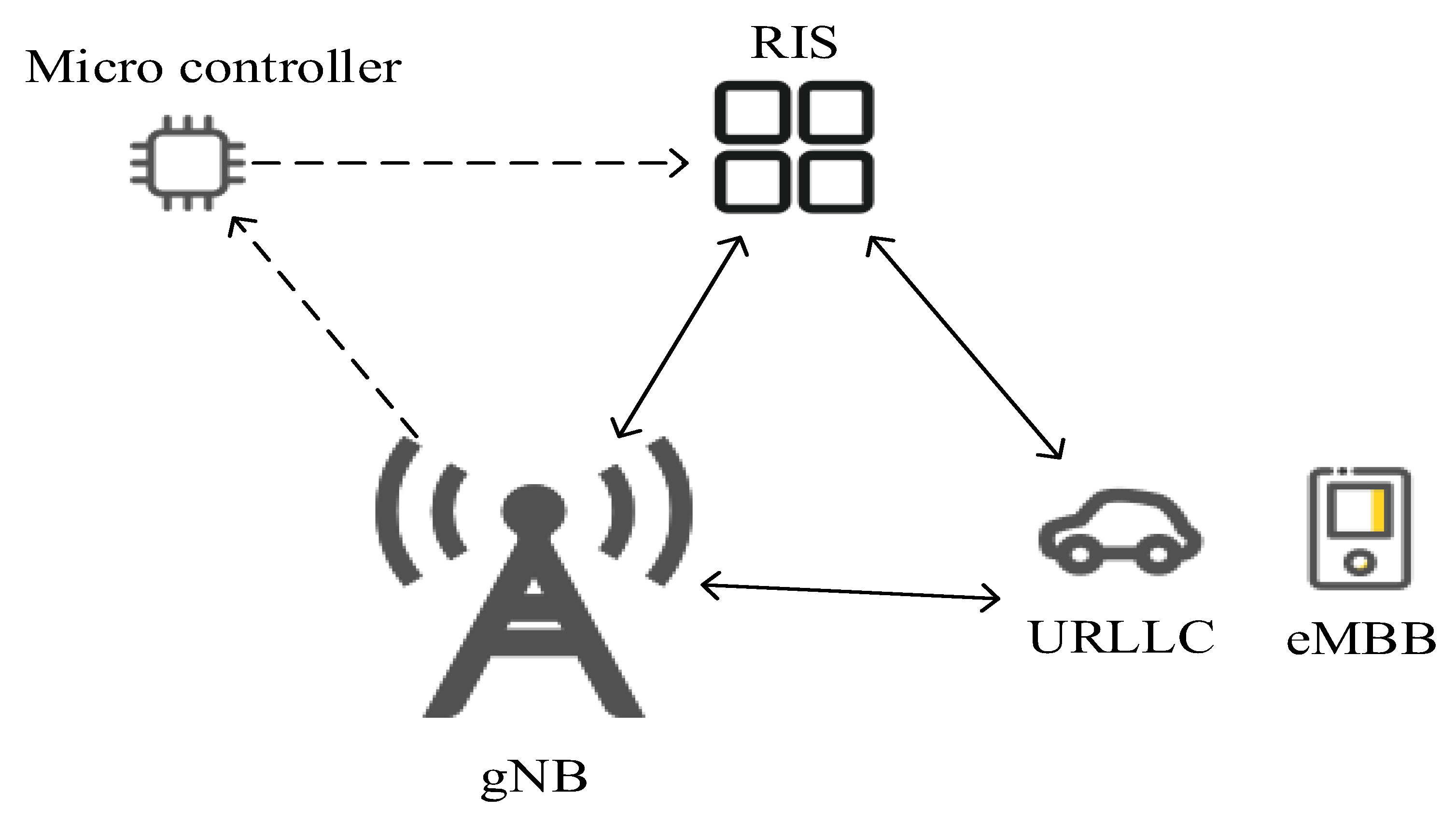

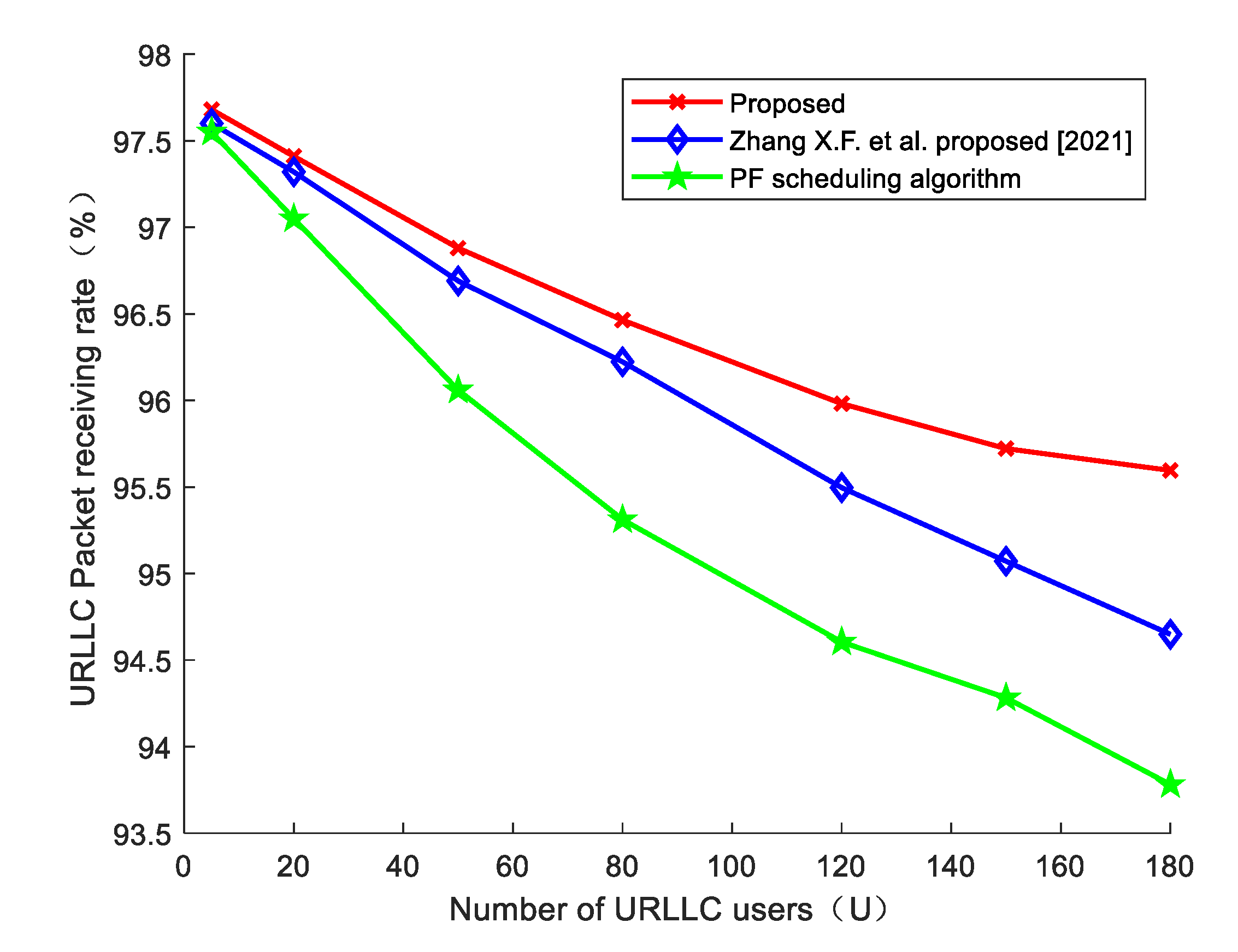
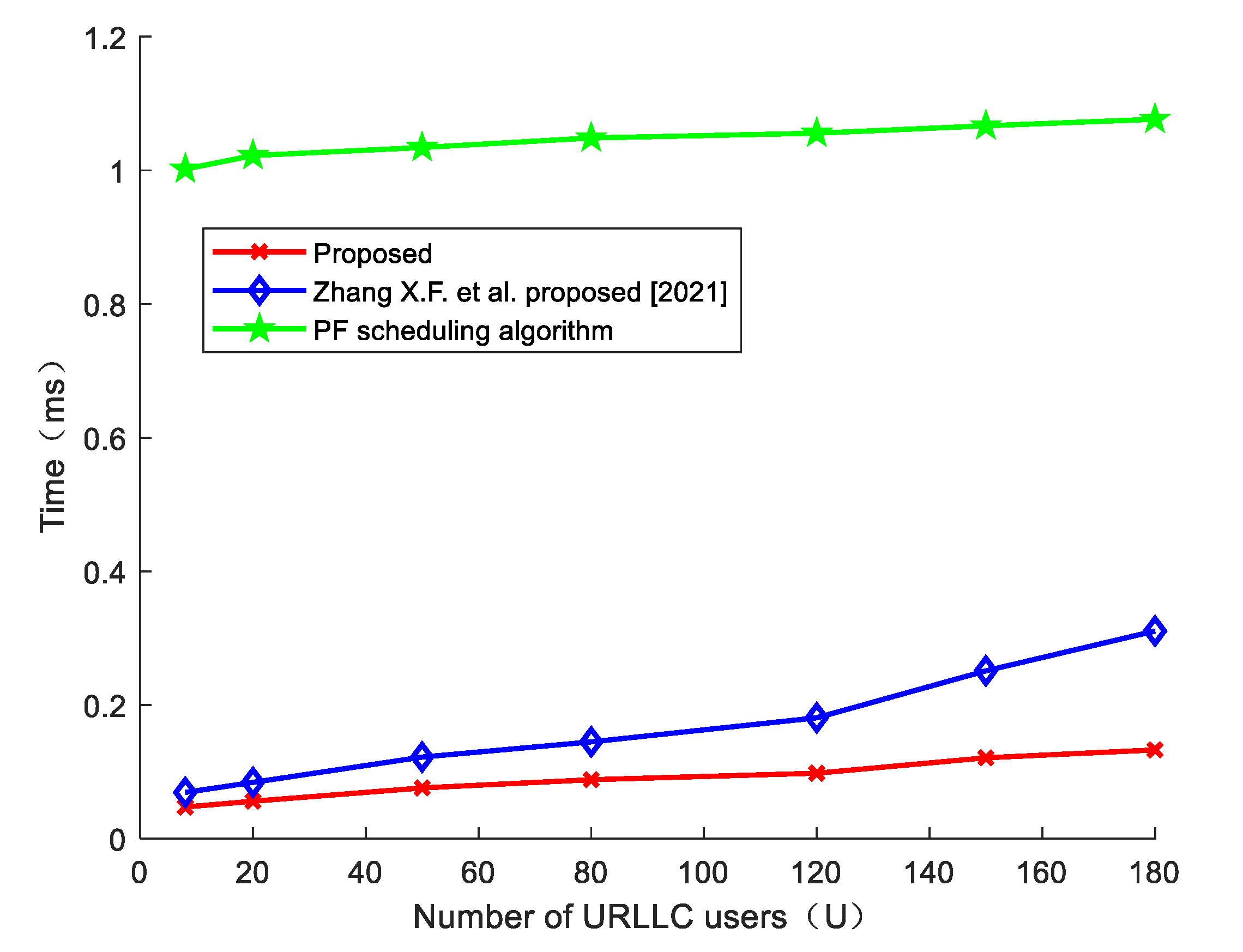

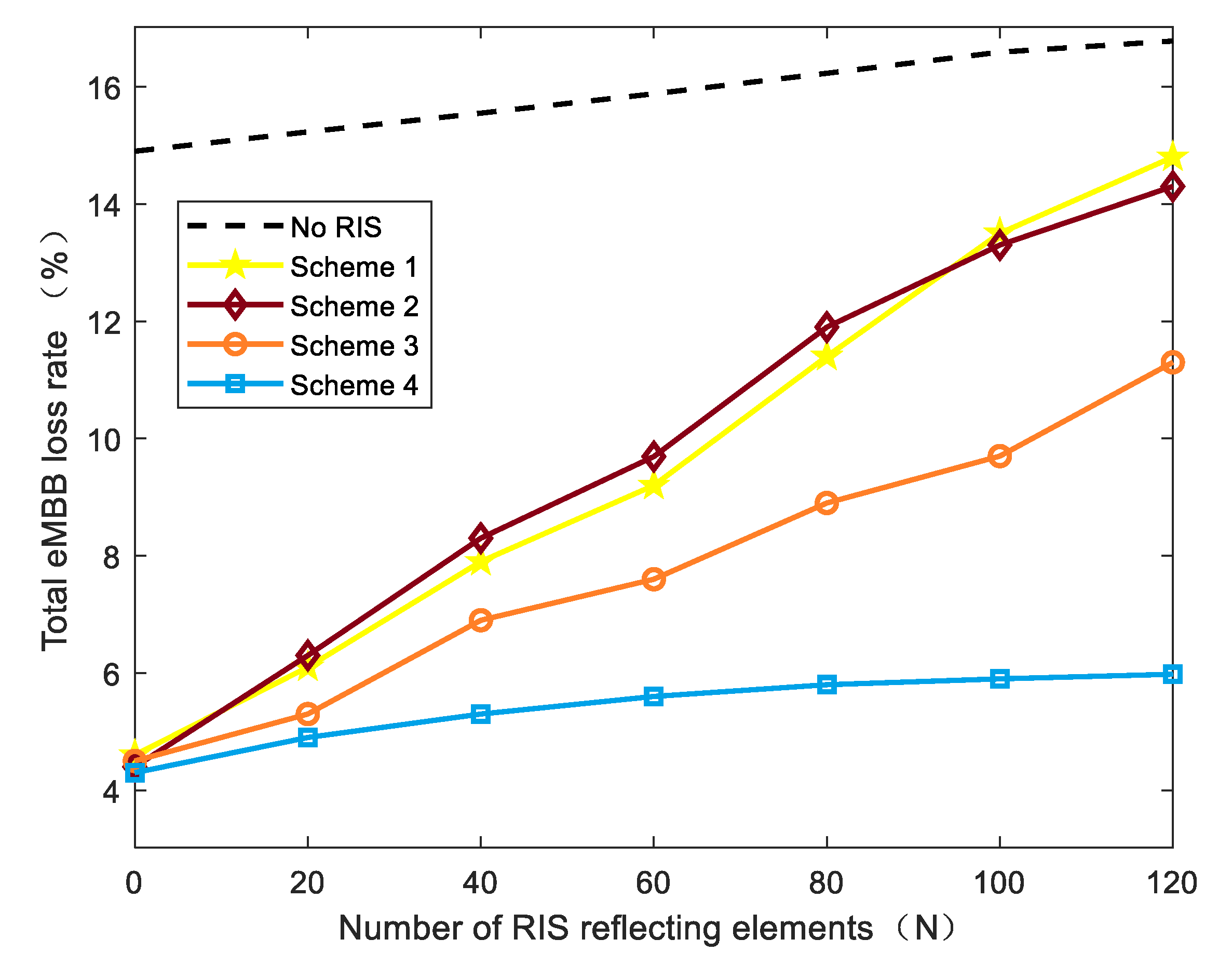
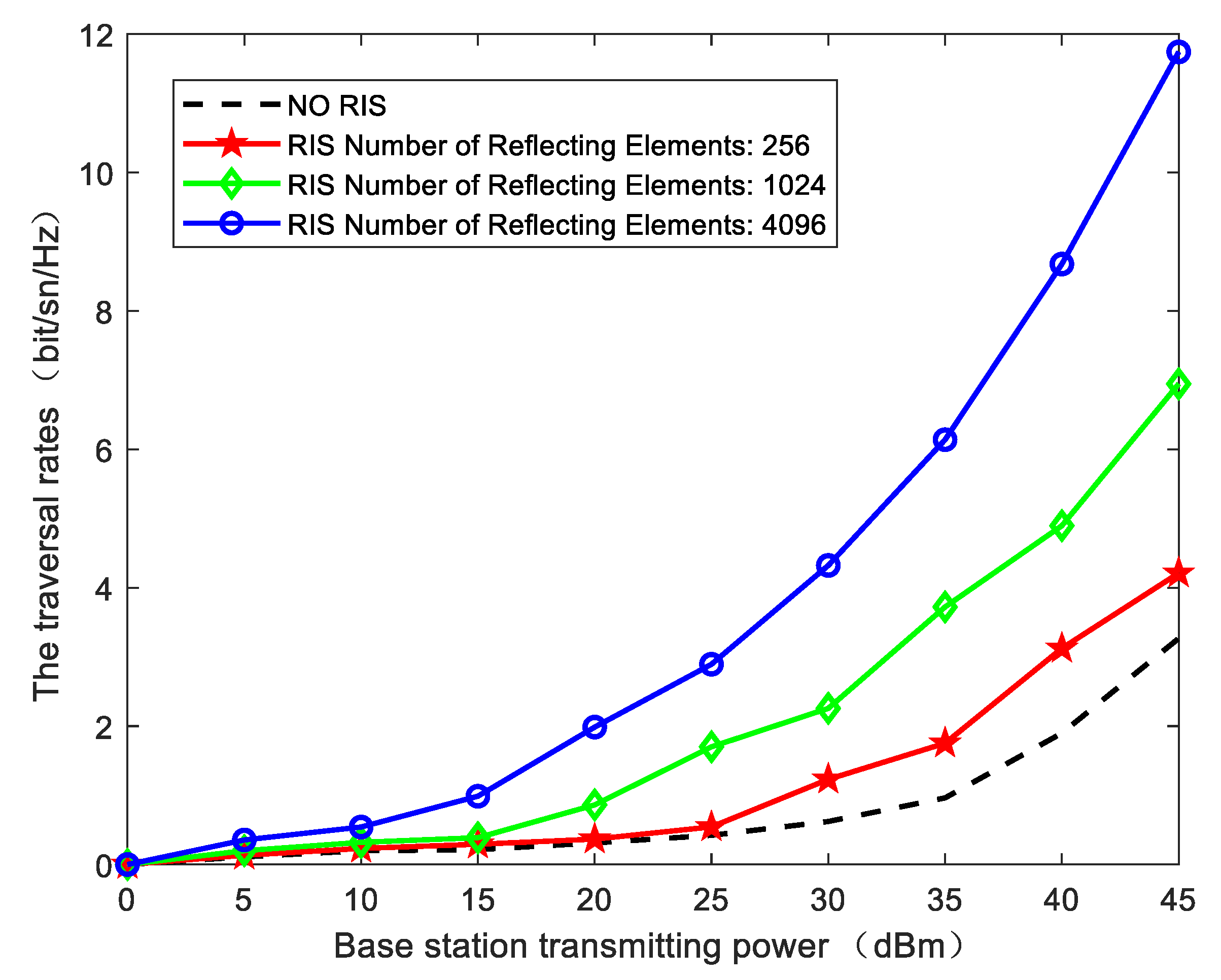
| Parameter | Value |
|---|---|
| Cell radius (r) | 300 m |
| The total bandwidth (B) | 20 MHz |
| RB bandwidth (BRB) | 180 kHz |
| The base station transmitting power (PgNB) | 46 dBm |
| URLLC maximum transmitting power () | 23 dBm |
| eMBB maximum transmitting power (Peb) | 23 dBm |
| Number of subcarriers per RB | 12 |
| URLLC transmission interval (sTTI) | 0.1443 ms |
| eMBB transmission interval (TTI) | 1 ms |
Publisher’s Note: MDPI stays neutral with regard to jurisdictional claims in published maps and institutional affiliations. |
© 2022 by the authors. Licensee MDPI, Basel, Switzerland. This article is an open access article distributed under the terms and conditions of the Creative Commons Attribution (CC BY) license (https://creativecommons.org/licenses/by/4.0/).
Share and Cite
Shen, X.; Zeng, Z.; Liu, X. RIS-Assisted Network Slicing Resource Optimization Algorithm for Coexistence of eMBB and URLLC. Electronics 2022, 11, 2575. https://doi.org/10.3390/electronics11162575
Shen X, Zeng Z, Liu X. RIS-Assisted Network Slicing Resource Optimization Algorithm for Coexistence of eMBB and URLLC. Electronics. 2022; 11(16):2575. https://doi.org/10.3390/electronics11162575
Chicago/Turabian StyleShen, Xianhao, Ziling Zeng, and Xin Liu. 2022. "RIS-Assisted Network Slicing Resource Optimization Algorithm for Coexistence of eMBB and URLLC" Electronics 11, no. 16: 2575. https://doi.org/10.3390/electronics11162575
APA StyleShen, X., Zeng, Z., & Liu, X. (2022). RIS-Assisted Network Slicing Resource Optimization Algorithm for Coexistence of eMBB and URLLC. Electronics, 11(16), 2575. https://doi.org/10.3390/electronics11162575






